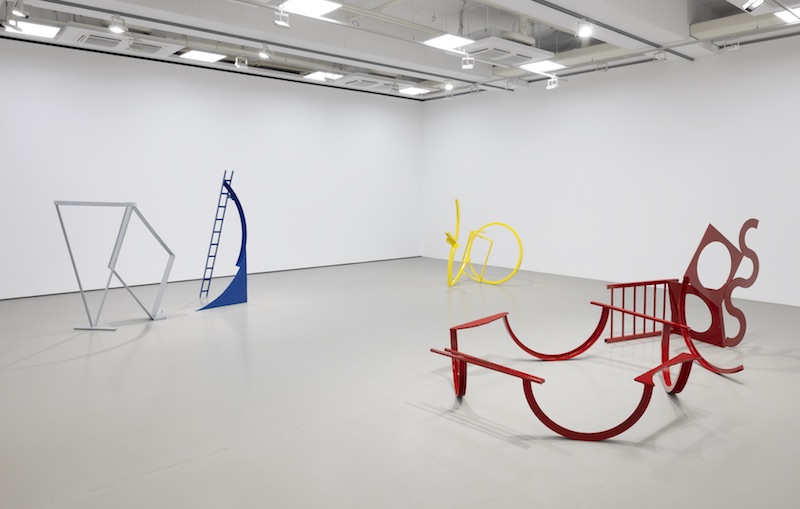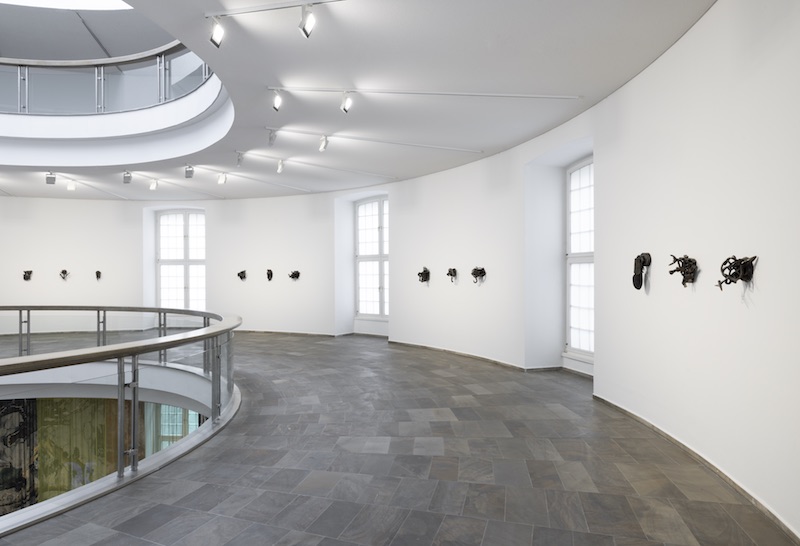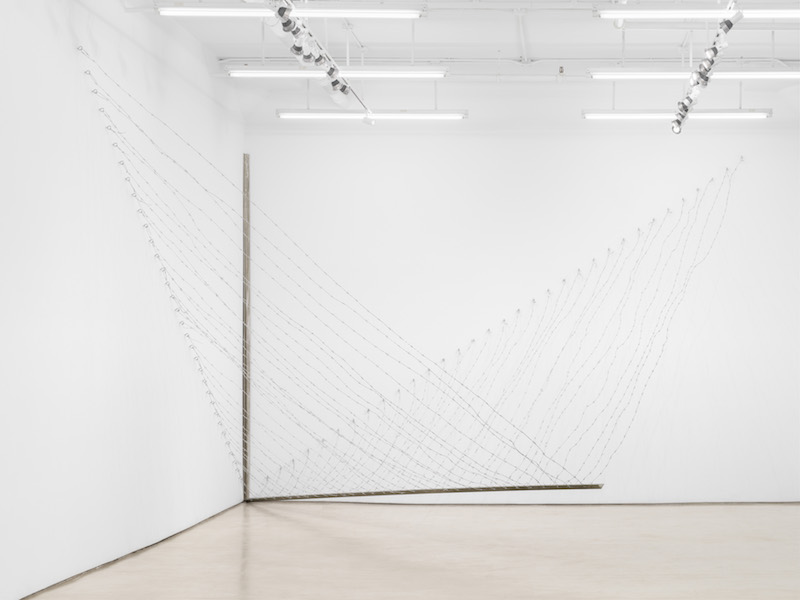by Fionn Adamian // Sept. 30, 2024
Melvin Edwards possesses a thoroughly enlivening process mania. Looking at the disciplined repetition of the pieces on view at his indispensable retrospective at the Fridericianum—the raw firmness of the steel creates a shared aura between the 13 examples of the ‘Lynch Fragments’ and the freestanding sculptures, while the spray painted silhouettes echo the pattern of the barbed wire installations—I thought about the complicated intimacy that must exist between Edwards and his materials. Formed by welded scraps of metal, the familial resemblance of the small, intensely enigmatic wall reliefs comprising the ‘Lynch Fragments’ gives the impression that they were made in a single burst of creative energy. This is not the case. In fact, starting in 1963, after studying painting at the University of Southern California where he also took an introductory class in welding that transformed the path of his artistic practice, Edwards has worked on the ‘Lynch Fragments’ almost continuously for his entire career, with brief interruptions from 1967 to 1972 and from 1974 to 1977.

Melvin Edwards: ‘SOME BRIGHT MORNING,’ with works (left to right) ‘Tan Ton Dynimus,’ 1974, ‘Augusta,’ 1974, ‘Felton,’ 1974, installation view Fridericianum Kassel // Photo by Andrea Rossetti, copyright Melvin Edwards, documenta and Museum Fridericianum gGmbH, courtesy Alexander Gray Associates, New York; Stephen Friedman Gallery, London; Galerie Buchholz, Berlin
The smart arrangement of ‘Lynch Fragments’ in the museum’s first-floor rotunda makes two deeply connected aspects of Edwards’ art stand out in trenchant contrast. One is his resolute orientation toward the process of sculpture rather than the finality of the art work, and the other is his investigation of art’s capacity to come to a phenomenal understanding of historical violence while refusing the devices of representation. Edwards calls these heart-sized works of industrial detritus, which confront the visitor at eye-level, “fragments” for a good reason. With a work like ‘Some Bright Morning’ (the title refers to a story from Ralph Ginzburg’s ‘100 Years of Lynching’ about a Black family’s armed self-defense against a white mob), the term might suggest that this sculpture of mangled steel stands for a shattered and recombined piece of historical evidence—the accursed relic of a white supremacist attempt at extrajudicial murder. But the fragment of ‘Some Bright Morning’ is also a literary form. It gives a conditional credence to the idea that violence leaves an unrepresentable void in its wake, but establishes a preeminent place—like the messianic fragments of Walter Benjamin’s ‘Arcades Project’—for the lightning-brief glimpse of history through an eloquent framing of its ruins, the balance of blade-like triangular shapes against the gradual spillage of chain-link.


Melvin Edwards: ‘SOME BRIGHT MORNING,’ with works from the series ‘Lynch Fragments,’ 1963–, installation view Fridericianum Kassel // Photo by Andrea Rossetti, copyright Melvin Edwards, documenta and Museum Fridericianum gGmbH, courtesy Alexander Gray Associates, New York; Stephen Friedman Gallery, London; Galerie Buchholz, Berlin
Often considered in dialogue with the cerebral traditions of abstraction, Edwards matches a lulling intelligence of pattern with a material that bites, as one can see from the sculpture ‘Lines for the Poet’: bolted into the corner at an approximately 45-degree angle, a steel pole acts as the relay for the parallel rows of barbed wire that snake from wall to wall like a lined sheet of paper. The sculpture-as-poem metaphor transforms the wire’s edges into the flecks of a pencil’s graphite: provisory commas, notations of iambic stress. But the sculpture itself is more lethal than metaphor. There’s no avoiding that the notional “lines” of this poem are in fact pieces of barbed wire, dangerously thrust into the viewer’s pathway, sharp enough to gouge an eye. Likewise, the concentric quadrilaterals of ‘Other Implications’ (another of Edwards’ barbed wire installations) might share certain compositional similarities with Josef Albers’ ‘Homage to the Square,’ but there’s still an important difference: abstraction by itself is incapable of making you bleed.

Melvin Edwards: ‘Lines for the Poet,’ 1970, barbed wire, stainless steel, dimensions variable // Photo by Dan Bradica, © the artist, courtesy the artist Alexander Gray Associates, New York; Stephen Friedman Gallery, London; Galerie Buchholz, Berlin
It’s impossible while looking at these works to ignore the cultural associations of barbed wire, a tool of internment and genocide. However, Edwards has been careful to emphasize, in interviews, the productive and even necessary use of the material as an enclosure for livestock. Let’s say this barbed wire is semiotically volatile: it seems to be pointing to starkly different scenes at the same time. As spectators, are we supposed to be frozen between these two possibilities? I assume that Edwards’ remark means that we should take his artwork dialectically. As in, we shouldn’t vacillate between seeing just a concentration camp or just a farm pasture in front of the barbed wire installations, but that these unsentimental lines are an almost aggressive object lesson in the way that every act of historical remembrance profiles a possible future against an irreparable loss. Bright though unburnished, Edwards’ oeuvre speaks with a commitment to making one thing and to making it again, better and modified to a new occasion, with anything at hand capable of withstanding the heat of a furnace: flat plates, chains, tubes, rakes, levers, hooks and garden hoes.
Exhibition Info
Fridericianum
Melvin Edwards: ‘Some Bright Morning’
Exhibition: Aug. 31, 2024–Jan. 12, 2025
fridericianum.org
Friedrichsplatz 18, 34117 Kassel, click here for map





















